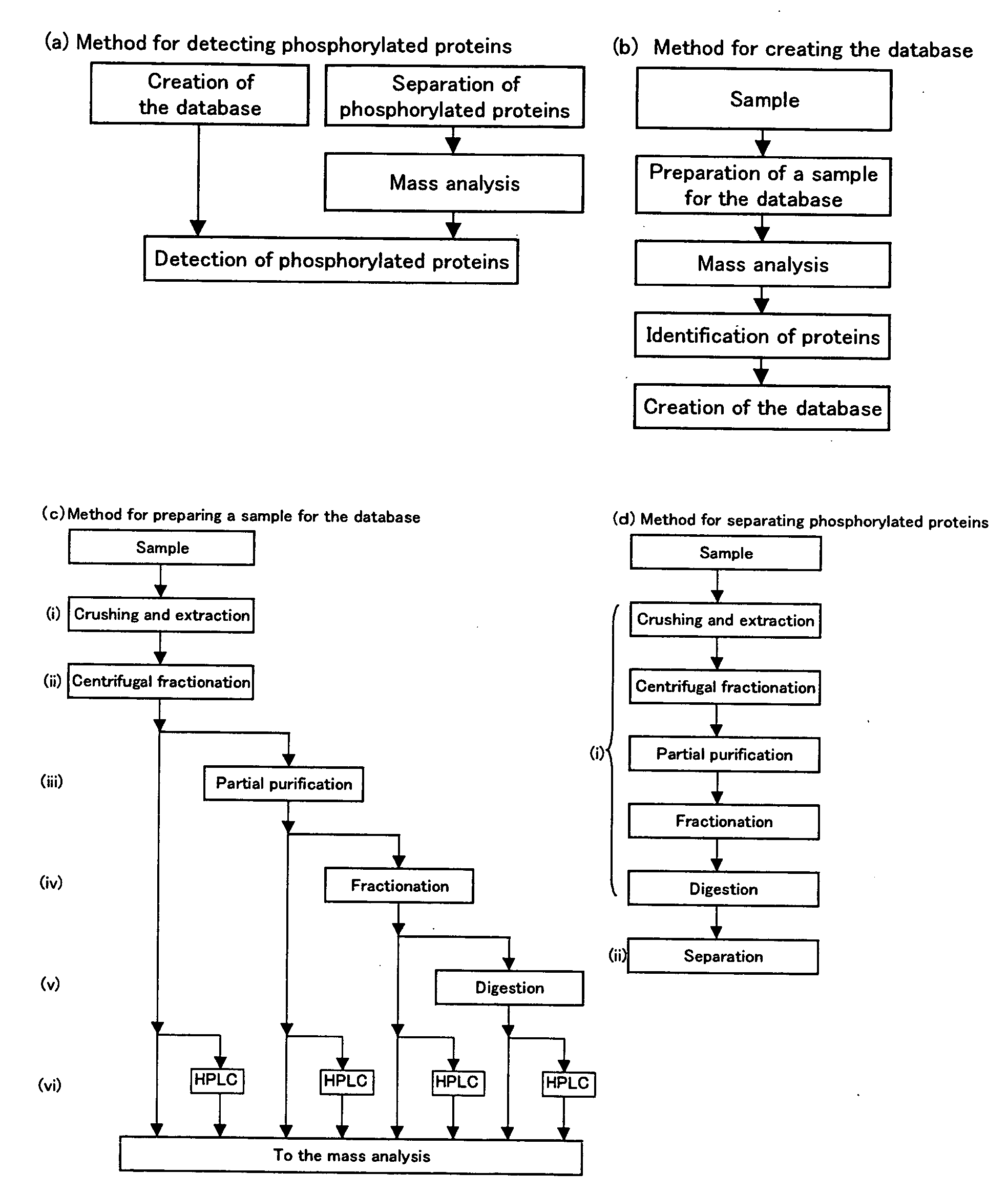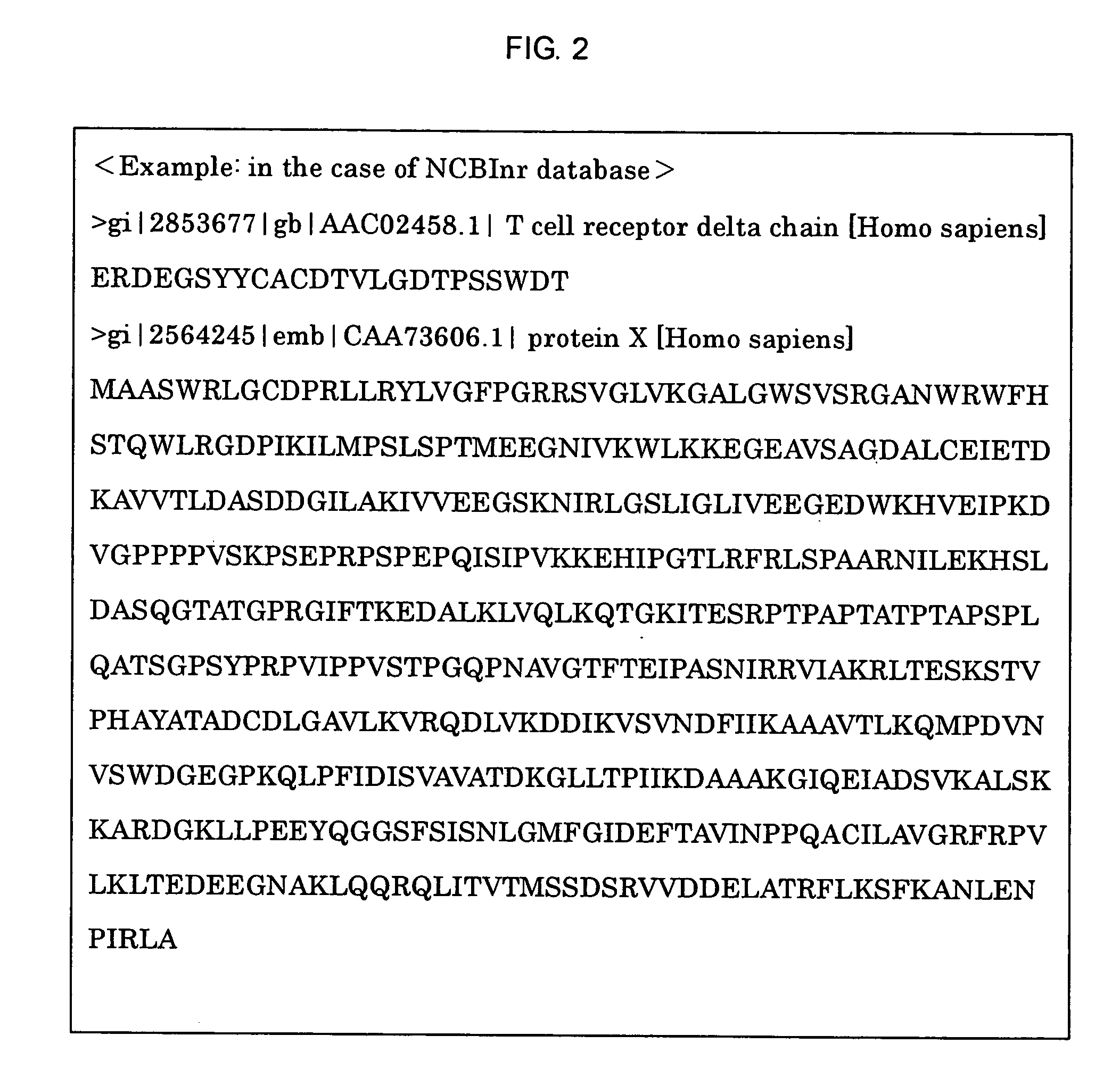Method of Proteome Analysis for Phosphorylated Protein
a proteome analysis and phosphorylated protein technology, applied in the field of proteome analysis for phosphorylated protein, can solve the problems of difficult to perform proteome analysis with high efficiency and high precision, and it is difficult to check mass spectra one by one, etc., and achieve the effect of short time period and high precision
- Summary
- Abstract
- Description
- Claims
- Application Information
AI Technical Summary
Benefits of technology
Problems solved by technology
Method used
Image
Examples
reference example 1
[0191]A Post Synaptic Density (hereinafter, referred to as “PSD”) fraction was prepared from the brain of a mouse by the following operation.
[0192]The whole brain was taken out from a seven weeks old BALB / c (female), ice-cooled PBS (containing protease cocktail; Roche: 1873580) was added thereto, and the whole brain was finely ground by a Teflon™-coated glass homogenizer. A solid content was removed as follows. The ground brain was centrifuged at 1400 G for 10 minutes to remove the precipitate. The supernatant was centrifuged at 13800 G for 16 minutes to collect the precipitate. The precipitate was suspended with 0.32 M sucrose. The sucrose was stacked in 1.2 M, 1 M and 0.85 M layers sequentially from the bottom, and the suspended sample was put on the top layer and centrifuged at 82500 G for 120 minutes. The fraction existing in the second layer from the bottom (Synaptosome) was collected and suspended with 0.32 M sucrose. Then, 6 mM Tris buffer solution was added thereto, and the ...
reference example 2
[0211]Under such circumstances, a database consisting of data regarding 888 proteins which were identified above was used for the search, instead of a database comprising information on a huge number of cases (e.g., NCBInr).
[0212]The database consisting of data regarding the 888 proteins which were identified above was created as follows. The gi number, which is key information for accessing the NCBlnr database was retrieved, and parts defining the protein names and the amino acid sequences were retrieved using a FASTA file of NCBInr used for the search. This was performed for all of the 888 proteins identified above, and thus a database of the FASTA format was newly created. The database created in this manner (hereinafter, referred to as a “database of this experiment”) was registered in the MASCOT so as to be searchable. The search conditions were as follows. Oxidation(M), Phospho(ST), and Phospho(Y) were designated as Variable Modification; the number of missed cleavages was set...
reference example 3
[0215]Next, purification of phosphorylated peptides was attempted.
[0216]0.1 mL of PHOS-SELECT (produced by Sigma) gel as one type of IMAC column was put into an Eppendorf tube, and mixed with 0.1% acetic acid for 30 seconds. The resultant substance was centrifuged, and the supernatant was discarded. This washing operation was repeated three times. Then, the PSD fraction obtained in reference example 1 was fractionated with a MonoQ column (produced by Amersham). Each fraction was digested with trypsin, and each resultant sample was mixed with acetic acid to be pH 3. Next, the resultant sample was added to PHOS-SELECT and slowly mixed at room temperature for 3 hours. Then, the supernatant was discarded after centrifugation, and the resultant substance was washed three times with 0.5 mL of 0.1% acetic acid. 0.5 mL of 0.15 M ammonia water containing 15% acetonitrile was added thereto, and the resultant substance was centrifuged. Then, the supernatant was collected, and the solvent was e...
PUM
| Property | Measurement | Unit |
|---|---|---|
| pH | aaaaa | aaaaa |
| volume | aaaaa | aaaaa |
| volume | aaaaa | aaaaa |
Abstract
Description
Claims
Application Information
 Login to View More
Login to View More - R&D
- Intellectual Property
- Life Sciences
- Materials
- Tech Scout
- Unparalleled Data Quality
- Higher Quality Content
- 60% Fewer Hallucinations
Browse by: Latest US Patents, China's latest patents, Technical Efficacy Thesaurus, Application Domain, Technology Topic, Popular Technical Reports.
© 2025 PatSnap. All rights reserved.Legal|Privacy policy|Modern Slavery Act Transparency Statement|Sitemap|About US| Contact US: help@patsnap.com



